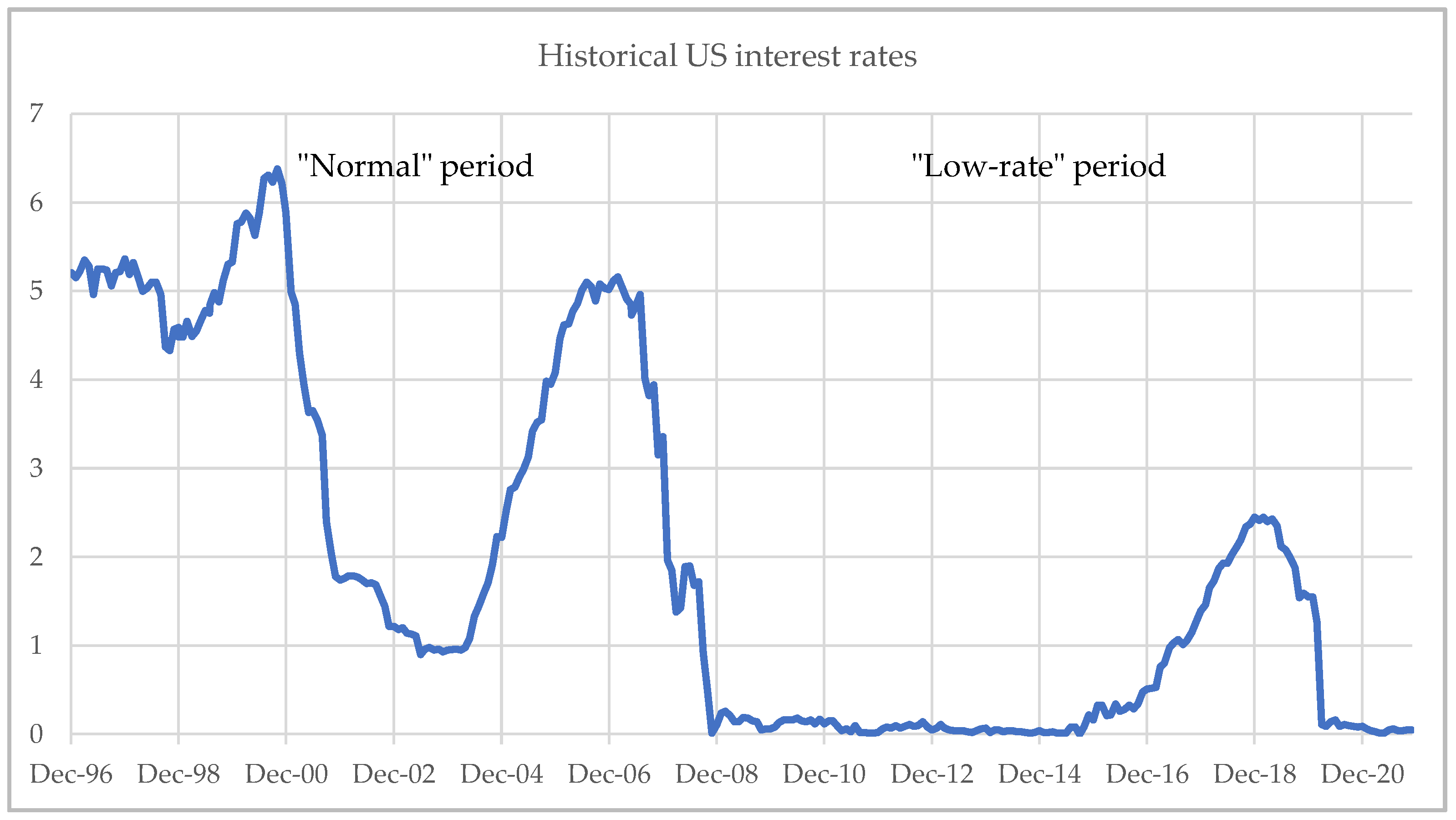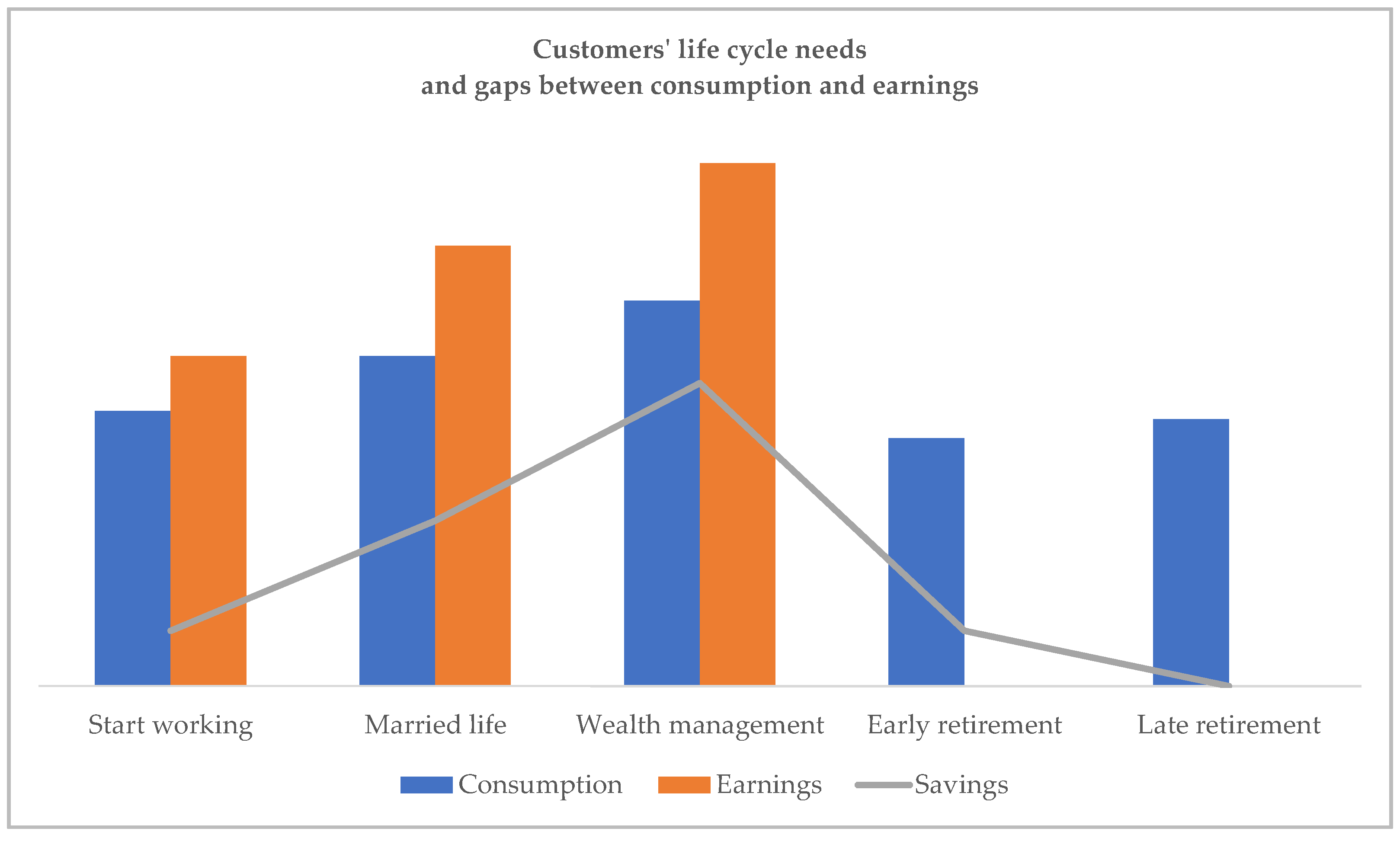How Do Life Insurers Respond to a Prolonged Low Interest Rate Environment? A Literature Review
Abstract
1. Introduction
- What has been the trend in global interest rates since 1990?
- How are life insurance products affected by a low interest rate?
- How do low interest rates change insurer valuation and solvency?
- How can financial management strategies respond to a prolonged low interest rate environment?
2. Conceptual Background
3. Materials and Methods
4. Results
4.1. Impacts of Low Interest Rates on Life Insurance Products
4.1.1. Interest Rate Sensitivity of Each Product Type
4.1.2. Product Shift Strategy
4.2. The Impact on Valuation of Life Insurance Companies
4.2.1. The Shift in Valuation Interest Rate
4.2.2. The Financial and Solvency Impacts
4.3. Solution Approaches
4.3.1. Short-Term Solutions
4.3.2. Long-Term Solutions
5. Discussion
5.1. Limitations
5.2. Interpretation and Implications of the Study’s Findings
Author Contributions
Funding
Data Availability Statement
Conflicts of Interest
| 1 | Basel III is an international regulatory accord rolled out by the Basel Committee on Banking Supervision to govern the banking sector’s ability to improve risk management and promote transparency. It sets appropriate risk-based capital as a cushion to deal with financial distress and maintain the continuity of bank operations (Bloomenthal 2020). |
| 2 | Solvency capital available based on eligible own funds (post-stress) divided by SCR (pre-stress). |
References
- Antolin, Pablo, Sebastian Schich, and Juan Yermo. 2011. The Economic Impact of Protracted Low Interest Rates on Pension Funds and Insurance Companies. OECD Journal: Financial Market Trends 1: 237–56. [Google Scholar] [CrossRef]
- Berdin, Elia, and Helmut Gründl. 2015. The Effects of a Low Interest Rate Environment on Life Insurers. The Geneva Papers on Risk and Insurance-Issues and Practice 40: 385–415. [Google Scholar] [CrossRef]
- Berends, Kyal, Robert McMenamin, Thanases Plestis, and Richard J. Rosen. 2013. The Sensitivity of Life Insurance Firms to Interest Rate Changes. Economic Perspectives 37: 47–78. [Google Scholar]
- Bloomenthal, Andrew. 2020. Basel III. Available online: https://www.investopedia.com/terms/b/basell-iii.asp (accessed on 18 May 2022).
- Bohnert, Alexander, Nadine Gatzert, and Peter Løchte Jørgensen. 2015. On the Management of Life Insurance Company Risk by Strategic Choice of Product Mix, Investment Strategy and Surplus Appropriation Schemes. Insurance: Mathematics and Economics 60: 83–97. [Google Scholar] [CrossRef]
- Borel-Mathurin, Fabrice, Pierre-Emmanuel Darpeix, Quentin Guibert, and Stéphane Loisel. 2018. Main Determinants of Profit-Sharing Policy in the French Life Insurance Industry. The Geneva Papers on Risk and Insurance-Issues and Practice 43: 420–55. [Google Scholar] [CrossRef]
- Borri, Nicola, Rosaria Cerrone, Rosa Cocozza, and Domenico Curcio. 2018. Life Insurers’ Asset-Liability Dependency and Low-Interest Rate Environment. In Mathematical and Statistical Methods for Actuarial Sciences and Finance. Edited by Marco Corazza, María Durbán, Aurea Grané, Cira Perna and Marilena Sibillo. Cham: Springer, pp. 185–89. [Google Scholar]
- Bowers, Newton L., Jr., Hans U. Gerber, James C. Hickman, Donald A. Jones, and Cecil J. Nesbitt. 1997. Actuarial Matehmatics. Schaumurg: The Society of Actuaries, pp. 512–15. [Google Scholar]
- Brown, Z. Margaret, and Lawrence Galitz. 1982. Inflation and Interest Rates: A Research Study Using the ASIR Model. Geneva Papers on Risk and Insurance. Geneva Papers on Risk and Insurance 7: 290–320. [Google Scholar] [CrossRef]
- Cronin, Matthew A., and Elizabeth George. 2020. The Why and How of the Integrative Review. Organizational Research Methods. [Google Scholar] [CrossRef]
- Cummins, J. David, Kristian R. Miltersen, and Svein-Arne Persson. 2007. International Comparison of Interest Rate Guarantees in Life Insurance Contracts. Available online: https://ssrn.com/abstract=1071863 (accessed on 18 May 2022).
- Dahl, Henrik. 1993. A Flexible Approach to Interest-Rate Risk Management. In Financial Optimization. Edited by Stavros A. Zenios. Cambridge: Cambridge University Press, pp. 189–209. [Google Scholar]
- Del Negro, Marco, Domenico Giannone, Marc P. Giannoni, and Andrea Tambalotti. 2019. Global Trends in Interest Rates. Journal of International Economics 118: 248–62. [Google Scholar] [CrossRef]
- Deutsche Bundesbank. 2013. Financial Stability Review 2013. Frankfurt am Main: Deutsche Bundesbank. [Google Scholar]
- Eling, Martin, and Stefan Holder. 2013a. Maximum Technical Interest Rates in Life Insurance in Europe and the United States: An Overview and Comparison. The Geneva Papers on Risk and Insurance-Issues and Practice 38: 354–75. [Google Scholar] [CrossRef]
- Eling, Martin, and Stefan Holder. 2013b. The Value of Interest Rate Guarantees in Participating Life Insurance Contracts: Status Quo and Alternative Product Design. Insurance: Mathematics and Economics 53: 491–503. [Google Scholar] [CrossRef][Green Version]
- Focarelli, Dario. 2015. ALM with Ultra-Low Interest Rates–(Life) Insurance Perspective. Available online: https://www.suerf.org/docx/l_1f0e3dad99908345f7439f8ffabdffc4_1475_suerf.pdf (accessed on 18 May 2022).
- Grosen, Anders, and Peter Løchte Jørgensen. 2000. Fair Valuation of Life Insurance Liabilities: The Impact of Interest Rate Guarantees, Surrender Options, and Bonus Policies. Insurance: Mathematics and Economics 26: 37–57. [Google Scholar] [CrossRef]
- Hartley, Daniel, Anna Paulson, and Richard J. Rosen. 2016. Measuring Interest Rate Risk in the Life Insurance Sector. The Economics, Regulation, and Systemic Risk of Insurance Markets, 124–53. [Google Scholar]
- Hogendoorn, Timo. 2019. An Introduction to IFRS 9 and IFRS 17. Available online: https://ifrs17explained.com/2019/08/09/an-introduction-to-ifrs-9-and-ifrs-17/ (accessed on 18 May 2022).
- Holsboer, Jan H. 2000. The Impact of Low Interest Rates on Insurers. The Geneva Papers on Risk and Insurance. Issues and Practice 25: 38–58. [Google Scholar] [CrossRef]
- Kablau, Anke, and Matthias Weiß. 2014. How Is the Low Interest Rate Environment Affecting the Solvency of German Life Insurers? Available online: https://www.bundesbank.de/en/publications/reports/financial-stability-reviews/list-of-references-768388 (accessed on 18 May 2022).
- Kablau, Anke, and Michael Wedow. 2012. Gauging the Impact of a Low Interest Rate Environment on German Life Insurers. Applied Economics Quarterly 58: 279–98. [Google Scholar] [CrossRef]
- Kling, Alexander, Andreas Richter, and Jochen Ruß. 2007. The Impact of Surplus Distribution on the Risk Exposure of With Profit Life Insurance Policies Including Interest Rate Guarantees. Journal of Risk & Insurance 74: 571–89. [Google Scholar]
- LePan, Nicholas. 2019. The History of Interest Rates over 670 Years. Available online: https://www.visualcapitalist.com/the-history-of-interest-rates-over-670-years/ (accessed on 18 May 2022).
- Love, Tom, and William C. Miller. 2013. Repercussions of a Sustained Low Interest Rate Environment on Life Insurance Products. Journal of Financial Service Professionals 67: 44–52. [Google Scholar]
- Macdonald, Angus S. 2004. Lidstone’s Theorem. In Encyclopedia of Actuarial Science. Edited by Jozef L. Teugels and Bjørn Sundt. Chichester: John Wiley & Sons, pp. 978–79. [Google Scholar]
- Nieder, Dirk. 2016. The Impact of the Low Interest Rate Environment on Life Insurance Companies. Reinsurance News 87: 16–21. [Google Scholar]
- Niedrig, Tobias. 2015. Optimal Asset Allocation for Interconnected Life Insurers in the Low Interest Rate Environment Under Solvency Regulation. Journal of Insurance Issues 38: 31–71. [Google Scholar]
- Paetzmann, Karsten. 2011. Discontinued German Life Insurance Portfolios: Rules-In-Use, Interest Rate Risk, and Solvency II. Journal of Financial Regulation and Compliance 19: 117–38. [Google Scholar] [CrossRef]
- Redington, Frank M. 1952. Review of the Principles of Life-Office Valuations. Journal of the Institute of Actuaries 78: 286–340. [Google Scholar] [CrossRef]
- Reyna, Ana M., Hugo J. Fuentes, and José A. Núñez. 2022. Response of Mexican Life and Non-life Insurers to the Low Interest Rate Environment. The Geneva Papers on Risk and Insurance-Issues and Practice 47: 409–33. [Google Scholar] [CrossRef]
- Romanyuk, Yulia. 2010. Asset-Liability Management: An Overview. Discussion Papers 10-10. Ottawa: Bank of Canada. [Google Scholar]
- Rybka, Lawrence J. 2017. Impact of Low Interest Rates on the Insurance Industry. Estate Planning 44: 26–30. [Google Scholar]
- Schmeiser, Hato, and Joël Wagner. 2015. A Proposal on how The Regulator Should Set Minimum Interest Rate Guarantees in Participating Life Insurance Contracts. Journal of Risk and Insurance 82: 659–86. [Google Scholar] [CrossRef]
- Shiu, Elias S. W. 1987. Immunization—The Matching of Assets and Liabilities. In Actuarial Science. Edited by Ian B. MacNeill and Gary J. Umphrey. Dordrecht: D. Reidel Publishing, pp. 145–56. [Google Scholar]
- Shiu, Elias S. W. 1988. Immunization of Multiple Liabilities. Insurance: Mathematics and Economics 7: 219–24. [Google Scholar] [CrossRef]
- Trading Economics. 2022. United States Fed Funds Rate. Available online: https://tradingeconomics.com/united-states/interest-rate (accessed on 29 July 2022).
- Van der Heide, Arjen. 2020. Making Financial Uncertainty Count: Unit-Linked Insurance, Investment and the Individualisation of Financial Risk in British Life Insurance. The British Journal of Sociology 71: 985–99. [Google Scholar] [CrossRef] [PubMed]
- Van der Meer, Robert, and Meye Smink. 1993. Strategies and Techniques for Asset-Liability Management: An Overview. The Geneva Papers on Risk and Insurance-Issues and Practice 18: 144–57. [Google Scholar] [CrossRef]
- Whittemore, Robin, and Kathleen Knafl. 2005. The Integrative Review: Updated Methodology. Journal of Advanced Nursing 52: 546–53. [Google Scholar] [CrossRef] [PubMed]
- Wieland, Jochen. 2017. Runoff or Redesign? Alternative Guarantees and New Business Strategies for Participating Life Insurance. European Actuarial Journal 7: 29–50. [Google Scholar] [CrossRef]


| Product | Structure | In-Force Block | New Business Block |
|---|---|---|---|
| Whole Life (WL) base plan only | Premium-dependent |
| |
| WL with Term Riders | Dividend-dependent |
| Higher illustrated premiums |
| Modified Premium WL | Dividend-dependent |
|
|
| Suspended Premium WL | Dividend-dependent |
| Inability to suspend premiums |
| Increase number of required out-of-pocket premiums | |||
| Universal Life (UL) with Secondary Guarantees | Premium-dependent |
|
|
| Most UL | Cash-value-dependent |
| Higher illustrated premiums |
| Variable UL with DB Guarantees (GMDB) | Premium-dependent | No impact on a guaranteed DB |
|
| Variable UL without GMDB | Cash-value-dependent |
|
|
| Indexed UL with GMDB | Premium-dependent | No impact on a guaranteed DB | Introduction of products with limited long-term guarantees |
| Indexed UL without GMDB | Cash-value-dependent |
|
|
Publisher’s Note: MDPI stays neutral with regard to jurisdictional claims in published maps and institutional affiliations. |
© 2022 by the authors. Licensee MDPI, Basel, Switzerland. This article is an open access article distributed under the terms and conditions of the Creative Commons Attribution (CC BY) license (https://creativecommons.org/licenses/by/4.0/).
Share and Cite
Suwanmalai, W.; Zaby, S. How Do Life Insurers Respond to a Prolonged Low Interest Rate Environment? A Literature Review. Risks 2022, 10, 155. https://doi.org/10.3390/risks10080155
Suwanmalai W, Zaby S. How Do Life Insurers Respond to a Prolonged Low Interest Rate Environment? A Literature Review. Risks. 2022; 10(8):155. https://doi.org/10.3390/risks10080155
Chicago/Turabian StyleSuwanmalai, Wilaiporn, and Simon Zaby. 2022. "How Do Life Insurers Respond to a Prolonged Low Interest Rate Environment? A Literature Review" Risks 10, no. 8: 155. https://doi.org/10.3390/risks10080155
APA StyleSuwanmalai, W., & Zaby, S. (2022). How Do Life Insurers Respond to a Prolonged Low Interest Rate Environment? A Literature Review. Risks, 10(8), 155. https://doi.org/10.3390/risks10080155






